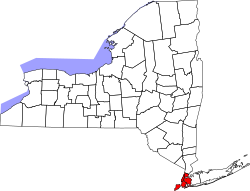| New York City Police Department Counterterrorism Bureau | |
|---|---|
 | |
| Abbreviation | CT |
| Motto | Fidelis ad Mortem Faithful till Death |
| Agency overview | |
| Preceding agency |
|
| Jurisdictional structure | |
| Operations jurisdiction | New York, New York, United States |
 | |
| Map of New York City Police Department Counterterrorism Bureau's jurisdiction | |
| Size | 468.9 square miles (1,214 km2) |
| Legal jurisdiction | New York City |
| Operational structure | |
| Headquarters | One Police Plaza |
| Deputy Commissioner responsible |
|
| Agency executive |
|
| Parent agency | New York City Police Department |
| Boroughs | List
|
| Website | |
| www1 | |
The New York City Police Department Counterterrorism Bureau (CT) is a division of the New York City Police Department (NYPD) responsible for preventing terrorist attacks within New York City. [1] [2] Former New York City Police Commissioner Raymond Kelly described the CT as "a Council on Foreign Relations with guns". [3]
Contents
- Current subdivisions
- Critical Response Command (CRC)
- Counterterrorism Division
- Joint terrorist task force (JTTF)
- Domain awareness system (DAS)
- Lower Manhattan security initiative (LMSI)
- Terrorism threat analysis group
- World Trade Center command
- See also
- References
In 2023, the counterterrorism and intelligence bureaus were merged into one bureau, under the supervision of Deputy Commissioner Rebecca U. Weiner. [4] [5] After the merger, Intelligence and Counterterrorism operate as 2 divisions under the combined bureau. Each division is commanded by an Assistant Chief or a Deputy Chief.